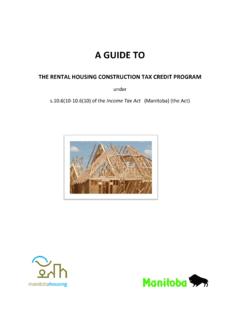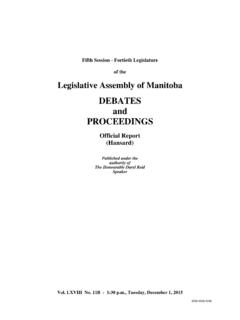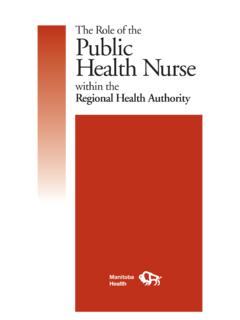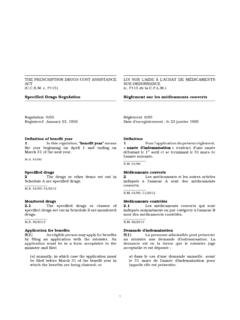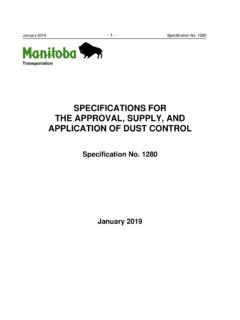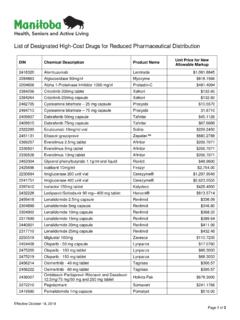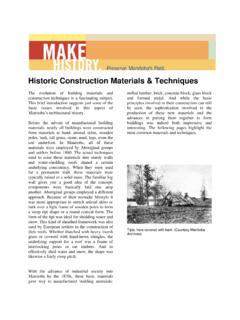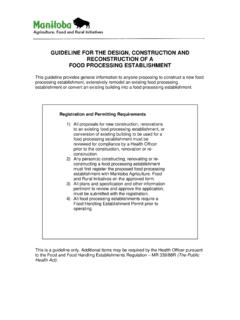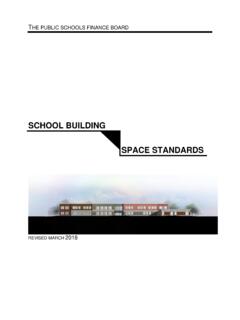Transcription of HERITAGE BUILDING MAINTENANCE MANUAL - Province of …
1 HERITAGE BUILDING MAINTENANCE MANUALThis MANUAL contains useful information on restoring and preserving HERITAGE buildings, but it is intended as a general guide only. The Provincial Government has taken all reasonable steps to ensure the accuracy of the information in this publication. However, it recommends that BUILDING owners consult with specialists, such as contractors, builders, plumbers, heating and air professionals and electricians, when doing any renovations, repairs or construction on their properties. The Province does not assume responsibility for any loss or damage resulting from reliance on the information in this INTRODUCTION 3 PART 1. WHAT IS MAINTENANCE ? 5 PART 2. PRE-PLANNING 7 PART 3. WHERE DO I START? 9 PART 4. MAINTAINING THE PARTS 15 BUILDING Envelope 15 Foundations 16 Exterior Walls 18 Roof 21 Gutters and Downspouts 24 Site Drainage 26 Windows and Doors 28 Features and Details 30 Energy Efficiency 33 PART 5.
2 WORKSHEETS 35 Inspection Checklist 36 MAINTENANCE Checklist 46 MAINTENANCE Record 54 Project Worksheet 55 Budget 56 Frequently Called Numbers 59 PART 6. REFERENCES 61 Toolkit Checklist 63 The Standards and Guidelines for the Conservation of Historic Places in Canada 65 Hiring a Professional 69 Troubleshooting 72 Resource List 75 The Historic Resources Branch gratefully acknowledges the support of the Government of Canada through the Historic Places Initiative, a federal, provincial, territorial BUILDING MAINTENANCE MANUAL - 12 INTRODUCTIONNo BUILDING is MAINTENANCE -free, so every structure, HERITAGE or new, requires care to limit to the elements causes all BUILDING materials to wear down eventually. Periodic inspections can help you find problems early and, along with regular MAINTENANCE , will extend the life of your BUILDING . They will also help you avoid the need for potentially expensive and disruptive repair work, which may damage your BUILDING s HERITAGE s a good idea to set up a BUILDING MAINTENANCE schedule to remind you of any inspections or work that needs to be done.
3 It will also help you prioritize MAINTENANCE , preventing avoidable, costly, future MAINTENANCE MANUAL as a GuideOne MAINTENANCE MANUAL does NOT fit all because every BUILDING is unique. This MANUAL provides general guidelines on topics common to most with the roof and moving through various major BUILDING components, the MANUAL focuses on typical issues of deterioration. There are worksheets included for your convenience. They will help you do regular inspections of your BUILDING to look for deterioration at its earliest stage. The MANUAL will also help you organize the MAINTENANCE and repair jobs that must be done MANUAL will help you: plan your BUILDING s MAINTENANCE to conserve your HERITAGE BUILDING maintain the basic parts of your BUILDING solve common problems of typical BUILDING systemsPlease note that this MANUAL provides a general overview of BUILDING MAINTENANCE and does not replace any operations or MAINTENANCE manuals published by the manufacturers of specific BUILDING materials.
4 Ensure any manuals or other publications you consult are appropriate to HERITAGE buildings in our unique climate. You may find that published advice on BUILDING topics such as insulation or moisture accumulation may not be applicable in materials and construction methods used in other areas of North America may be similar, yet significantly different, from those used in manitoba . Relying on out-of- Province manuals can lead to inappropriate MAINTENANCE HERITAGE Buildings Unit team invites your MAINTENANCE -related questions, comments or suggestions. Please contact: HERITAGE Buildings UnitHistoric Resources BranchManitoba Culture, HERITAGE , Tourism and SportMain Floor, 213 Notre Dame , MBR3B 1N3 INTRODUCTION 3 Phone: 1-204-945-2118 Toll free: 1-800-282-8069, ext. 2118 Fax: 1-204-948-2384E-mail: 1:WHAT IS MAINTENANCE ?PART 1:WHAT IS MAINTENANCE ?PART 1. WHAT IS MAINTENANCE ?All BUILDING materials decay eventually due to sunlight, rain and wind, and therefore they require continued attention if a BUILDING s condition is to be maintained.
5 Modest spending on regular MAINTENANCE can reduce the need for costly repairs, protect the fabric of your BUILDING and save you money in the longer term. As defined by the Standards and Guidelines for the Conservation of Historic Places in Canada (2004), MAINTENANCE is: Routine, cyclical, non-destructive actions necessary to slow the deterioration of a historic place. It entails periodic inspection; routine, cyclical, non-destructive cleaning; minor repair and refinishing operations; replacement of damaged or deteriorated materials that are impractical to can be broken down into three categories: Corrective MAINTENANCE : work necessary to bring a BUILDING to an acceptable level (often recommended by a conservation plan), such as treatment for moisture. Emergency MAINTENANCE : work that must be done immediately for health, safety or security reasons or that may result in the rapid deterioration of the structure or fabric if not done, such as roof repairs after a storm or repairing broken glass.
6 Planned MAINTENANCE : work to prevent problems which can happen predictably within the life of a BUILDING , such as cleaning gutters or best type of protection is to do regular and routine MAINTENANCE , to prevent extensive and expensive repairs. MAINTENANCE planning must be consistent with your needs and respectful of your financial means, while ensuring that your BUILDING is evaluated annually. A plan that is too complicated or onerous will simply not get of the work we are encouraging in this MANUAL is planned MAINTENANCE . In the initial phases of developing a MAINTENANCE plan, there may be corrective or emergency MAINTENANCE that must be done before a routine, cyclical approach can be Importance of MaintenanceGiven the importance of material integrity in a HERITAGE BUILDING , it is obvious that, whenever the option presents itself, preserving an original BUILDING element is preferred to a replica.
7 To ensure that a BUILDING maintains its integrity, it is critical that MAINTENANCE takes a leading role in a BUILDING owner s plans and maintaining HERITAGE sites -- repairing, cleaning, or correcting defects -- we are not only preventing deterioration of precious original materials, we are also ensuring that possible hazards are avoided. The purpose of MAINTENANCE is to ensure longevity, reduce costs and improve what is the dividing line between MAINTENANCE and repair? Basically, if things are let go too long, you can almost be assured of more serious problems. Occasionally, materials such as roof shingles, will require replacement. However, the implementation of a diligent MAINTENANCE program will limit the need to repair or replace on a large scale and extend the life of those original 1. WHAT IS MAINTENANCE ? 56 PART 2:PRE-PLANNINGPART 2:PRE-PLANNINGPART 2. PRE-PLANNINGT here are several practical questions a BUILDING owner should ask before undertaking MAINTENANCE work.
8 Answering these questions will help establish the scope of work and will allow a BUILDING owner to identify the various resources that will make the work a you undertake the work yourself? To answer this question you need to know exactly what the job will entail. Consider any special skills required such as turning wood on a lathe or the proper strike when repointing masonry. In your day-to-day activities involving family, work and other interests, do you have the time you will need to commit to the project you are planning? Should you hire someone else to do the work? Is it physically possible for you to carry out the work without the committed assistance of others? Can you rely on the assistance of others for the duration of the project? If you are unable to carry out all the work yourself, you will need to consider where to find the appropriate trades required for the you undertake the work safely?
9 Are you aware of all the necessary precautions that must be observed with all aspects of the job? For example, it s not unusual for people to be unaware of dangerous compounds that form when mixing chemicals. And that materials such as asbestos siding and urea-formaldehyde foam insulation (UFI) require specific protective equipment and disposal. Safety harnesses, headgear, footwear and breathing equipment are just a few of the pieces of items required for BUILDING -related work. Are these items available to you and do you know how and when to use them? The safety of occupants, visitors to the site and the general community must be considered when any project is planned. Be aware of Health and Safety regulations. Even as a volunteer organization, you will be held responsible in the case of an accident. Proper signage and fencing of the worksite are just a few considerations for the safety of the planned tasks affect other parts of the site?
10 Often, a MAINTENANCE project can affect other parts of a BUILDING . For example, applying a waterproof coating to prevent moisture penetration could damage the masonry. If these byproducts of your work are not anticipated, then you may not budget the right amount of resources to ensure a satisfactory outcome. If you are undertaking a project that requires the placement of heavy equipment outside the BUILDING , consider the damage the equipment may make to your grounds, fencing or neighbouring properties. Whenever you are planning a project, think about how your work activities, or the activities of others on the project, may affect areas that are not within the scope of the 2. PRE-PLANNING 7Is your budget realistic? The potential for unforeseen events or delays during the course of a renovation project are always present and can greatly affect the final cost of the work. Unwelcome surprises in the BUILDING itself (especially in walls, where shoddy work may have been masked, or where an unusual procedure has been employed) can also escalate costs.
